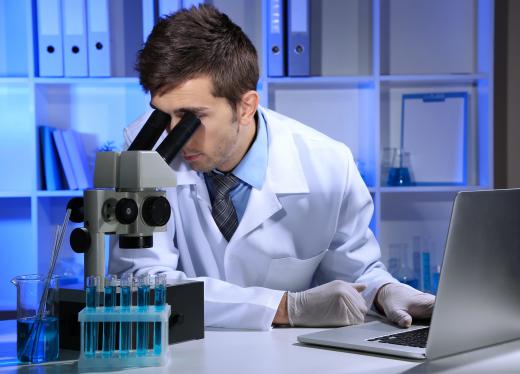What Is Cycloheximide?
 Mary McMahon
Mary McMahon
Cycloheximide is a bacterial toxin that interferes with the process of protein biosynthesis, something cells use to build proteins in order to perform various functions. Lab researchers use this compound in experiments where they need to control the expression of proteins. It is available through scientific suppliers, who can provide it in various forms for different types of research. It is not safe for use in living organisms, as it is associated with birth defects and is known as a teratogen, a compound that can cause physical abnormalities. Technicians must be careful around it to reduce the risk of exposure.
In nature, the bacterium Streptomyces griseus produces this compound. Scientific supply companies can use several techniques to produce a very pure form and isolate it for sale to customers. It is often sold as a powder which technicians can rehydrate when they are ready to use it. This is convenient for transportation and storage purposes, as powders are lighter than liquids and can be sealed in packaging to limit the risk of spills along the way.

When cycloheximide enters a eukaryotic cell, one with complex structures like organelles, it interrupts the protein biosynthesis process at the translation stage. This is the phase where messenger RNA (mRNA) with genetic information is decoded by the ribosome of the cell for the purpose of building a protein. When the process is interrupted, the cell cannot build a protein, or may generate errors in the finished product.
Researchers can use cycloheximide in various experiments where they want to control protein production among cells growing in culture. It can also be useful as an antibiotic for various tissues grown in culture. Additionally, researchers may use it to regulate plant growth. Its uses are primarily lab based because of the human and animal health risks associated with cycloheximide in the wild; while it can be used as a fungicide, for example, the teratogenic concerns tend to outweigh its potential applications as a fungal treatment.
Lab environments can take advantage of this and many other compounds for research purposes. They are supplied for scientific research only and are not intended for use as a medication in humans or animals. Other antibiotics are available to treat living organisms that may benefit from therapies that disrupt protein biosynthesis. Workers who encounter cycloheximide and similar chemicals typically wear appropriate protection to limit exposure and avoid inadvertent contamination of their experiments.
AS FEATURED ON:
AS FEATURED ON:











Discuss this Article
Post your comments